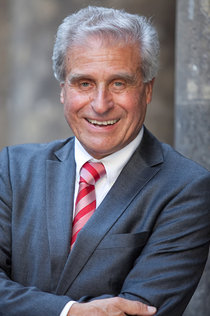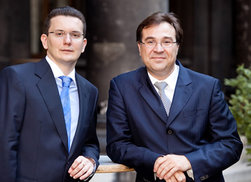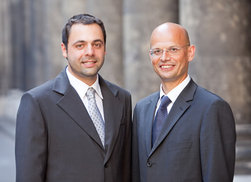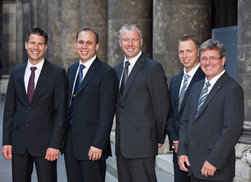Winners 2009
Main Prize
Prof. Dr. Gerd Wegener
The winner of Main Prize for 2009 is Prof. Dr. Gerd Wegener from Munich, Germany. Well known in the Forest Based Sector worldwide– both in the scientific community and in Forest Based Industries - he has been inspiring generations of scientists as well as managers. His broad interests and knowl-edge in the field of Wood Science, together with his admirable commitment as editor of major European scientific journals such as “Wood Science and Technology” and “European Journal of Wood and Wood Products”, made him an outstanding expert in this field. His innovative research has resulted in numerous new technologies and products.
Especially as a teacher and a speaker at conferences and seminars all over the world, he is an outstanding ambassador for wood science as well as for wood utilisation in general. His impressive career and achievements and his ongoing inspiration for innovative R&D convinced the jury to decide in favour of Prof. Wegener
Innovation Prizes (6 projects have been awarded)
ADAPT –new strategy for future forest management based on climate change
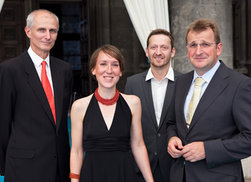
from left to right:
Norbert Putzgruber, Alexandra Wieshaider, Werner Rammer, Manfred Lexer, Rupert Seidl (not on the photo)
The winning project deals with the problem of planning with a moving target, in the specific case of climate change. As forest management is always very much future-oriented – plans have to be made at least several generations in advance – nowadays it is of the utmost importance to take climate change into consideration. Several tree species will not be suitable in future in specific regions, because they cannot cope with new conditions such as higher temperatures or less rain. Taking into account the observed regional data of all districts within a big forest enterprise, it is possible to create a special simulation programme, which allows foreseeing upcoming problems such as weakened trees, beetle attack and possible storm calamities. Based on that knowledge, focused actions can be planned and implemented in favour of sustainable forest management. This system is already implemented in one of the biggest forest companies in Austria and is already foreseen to be licensed for other forest companies, even in Canada.
CADIX – The alarm system for detecting termite attacks
The winning project deals with a big problem for the South European construction sector –termites. They occur in regions with mild Mediterranean climate, but we have to be aware that they will con-quer more northern regions in future as a result of climate change. Belonging to the cockroach fam-ily, they destroy any wooden construction easily. This presents a major obstacle for building with wood in southern Europe. This project presents an alarm system based on a motion sensor. It con-sists of only a very small box, which is installed in an endangered wooden element, such as a beam or window frame. As soon as a movement that is similar to that of a termite is detected, the alarm is triggered. The system has a wireless connection to a computer, which generates both acoustic and optical alarms. Termite attacks can then be detected at an early stage and wooden buildings can be protected before it is too late. This is a vital contribution for an enhanced use of wood in Southern Europe.
TimberTower – The first modular timber tower for high performance wind energy plants
The winning team convinced the jury with a revolutionary concept. Instead of steel or concrete they use wooden modules for constructing towers for wind energy turbines. The static calculations and design of wooden towers is an outstanding feature of engineering. This project not only opens a new field for wooden construction, but also solves a fundamental logistical problem. Towers of steel and concrete have to be pre-fabricated whole and transported to the site. The transport of large towers is very costly and complicated, whereas prefabricated wooden modules are smaller and much easier to transport to the site. They also allow on-site construction - THE advantage of wood in general. Moreover, the prizewinning team developed a wood protection system using a membrane in order to protect the wooden tower from weathering. The first tower will be built in autumn in the Hannover region of Germany. This is a perfect combination of exploiting natural wind energy and using renewable building material!
Eco-friendly in-depth coloration of solid wood with the help of supercritical CO2
The basic idea of this winning project was to develop a wood colourant with a high penetration depth making use of a supercritical fluid. A substance becomes a supercritical fluid at a temperature or pressure above a critical point where distinct liquid or gaseous forms do not exist. a It can diffuse through solids like a gas, and dissolve materials like a liquid. The penetration is instant and dry, which makes supercritical fluids optimal carriers of the pigment. The most important advantage of this method is the lack of moisture, which always creates problems with the dimensional stability of wood. Moreover, no poisonous solvents are needed. The project is in an early stage, but very promising first for the wood flooring sector but also for the (interior) design sector in general. As it is very complicated to colour wood to high penetration depth, often tropical wood species are used instead of painted wood. Painted wood cannot be sanded when small blemisheshave occurred on the surface. By contrast, depth-coloured wood can be refurbished easily without losing its original colour.
Innovative lightweight sandwich panels made of wood and wood based materials
This award-winning light-weight panel solves a major problem within the furniture and automobile industries. There is a growing need for light-weight elements, which have to perform under en-hanced load conditions. This type of panel shows several innovative elements. One new feature is the middle layer, which consists of a fibre mat pressed into corrugated form in both directions. This specific form is also able to withstand transverse tensile forces, which is not common for wood-based panels. Secondly, the surface layers are milled accurately in order to match perfectly with the form of the inner layer. This, and the gluing exactly on those spots, guarantees a good fit and opti-mum transmission of power– the most important properties for high-performance sandwich panels. The panels are already implemented in furniture, as well as in vehicles such as caravans, as lightweight wall elements.
First industrial production of synthetic natural gas (SNG) of wood
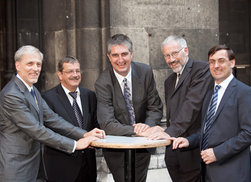
from left to right
Christian Aicherning, Martin Schaub, Reinhard Koch, Alfred Waser, Hermann Hofbauer
This project marks a milestone in the history of renewable energy from wood. The award-winning consortium has already broad experience with wood-gasification and gas driven energy plants. Now they have taken a further step by introducing a new process that results in a synthetic natural gas (SNG) with higher quality than natural gas. The gas can be fed into gas pipelines without any further treatment; it can be produced regionally in order to provide cities or regions with natural gas for energy plants or heating. Moreover, it makes a large contribution to a new generation of fuels from renewable sources. SNG is suitable either for gas-driven vehicles or as basic product for diesel or petrol. The winning team have already succeeded in installing a methane processing unit in Austria


